The bells of the church St. Lubentius in Dietkirchen
The first bells
From today’s perspective, it is no longer possible to trace exactly when the very first church bells were hung in the church and made their ringing sound. According to W.H. Struck in DAS STIFT ST. LUBENTIUS IN DIETKIRCHEN, 1986, he proves the existence of bells, however, indirectly through the presence of the former Ottonian west tower and the Staufer double tower which still exists today, as well as the existence of a bell ringer who was mentioned in a last will of Dean Heinrich in 1262. (See Struck, Quellen zur Geschichte der Klöster und Stifte im Gebiet der mittleren Lahn, page 10, no. 7). A concrete reference to an existing bell is given in the statutes for the canons of 1282 with a prohibition of unseemly clothing at vespers or any other hour when the bell rings (Str 2 p. 14 Nr. 11).
1914 Bells before the 1st world war
Before the time of World War I, were amongst the oldest bells the bell dedicated to the Trinity from 1753 and the smallest from 1661 (Luthmer 3 p. 164). The bell of 1753 has a diameter of 1 m and a weight of 700 kg. The trinity bell has the tone “g”. It has the inscription “AD HONOREM SANCTAE TRINITATATIs CONFLATA” and under it names of canons (Luthmer 6 p.22), more exactly: of the dean, the six capitulars and the two vicars (friendly information of the Mr. Domkustos Joachim Pick to Limburg from 13th December 1984).
Below this inscription was another inscription with the names of the dean, the 6 capitulars and 2 vicars.
Dean
Johannes Carolus Klein, from Wiltz (1741-1772)
Capitular:
Johann Distel (Distell), 1700-1755
Franciscus Hetzrodt (Hetzenrodt, Hetzrath), 1730-1780
A. J. F. Diel, 1774-1783
H. P. Armbruster, 1760-1771
Carl Heinrich Ignatius (Josephus) Flörchinger, from Saarburg, 1748-1803
Franz Friedrich Jacobus (Josephus) Carove, 1752-1799
Vicar:
Antonius Digitolo, from Limburg, 1722-1775
Franciscus Antonius Neve, from Ladenburg, 1743-1781
In 1752 the monastery commissioned the casting of five new bells (See Struck, DAS STIFT ST. LUBENTIUS IN DIETKIRCHEN, 1986, p. 28). It can be assumed that the Trinitatis bell (Trinity Bell) was one of them.
1917 Confiscation of the bells during World War I
However, 5 September 1917 was a black day for the bells of the St. Lubentius church at that time. The military authorities had confiscated three of the four bells and on 5 September they were handed in.
The Dietkirchen school chronicle describes the 3 confiscated bells as follows.
1. The big bell.
She had the tone “es“. Its lower diameter was = 1.25 m, the height = 1.20 m. She had six curved handles. On the neck of the bell was a wreath of ornaments. This consisted of ears of corn, vine leaves and grapes.
The inscription read (original german text):
My name is Maria.
May His peace be given to you, in this
Life, by the redeemer, my son,
In the future eternal rest
Is my wish to you
Christ’s faithful children.
Arnold Haas. Pastor.
Dietkirchen, November 1850.
Cast at Hof = Sinn near Herborn
by P. H. Rincker.
The weight was = 1150 kg. It cost 1327 Fl. 33 Kr.
1 Fl = 1 Gulden.
1 FL = 2 KR (Kronen)
In the year 1850 the value of 1 Gulden = 13,4 Euro
1327 Gulden = 17781,8 Euro + 33 KR = 221,1 Euro
Total 18002,9 Euro
The inscription read (original german text):
Mein Name ist Maria.
Seinen Frieden gebe euch, in diesem
Leben der Erlöser, mein Sohn,
Im künftigen die ewige Ruhe
Ist mein Wunsch an Euch
Christgläubige Kinder.
Arnold Haas. Pastor.
Dietkirchen, im November 1850.
Gegossen zu Hof = Sinn bei Herborn
von P. H. Rincker.
Das Gewicht betrug = 1150 kg. Sie kostete 1327 Fl. 33 Kr.
2. The eight a’clock bell.
She had the tone “b”. The lower diameter was = 0.85 m, the height = 0.83 m. The weight was 375 kg. It had four curved handles. At the neck was a decorative band representing leaves of the oak.
The inscription read:
St. Joseph, Patrone Totius Ecclesiae,
ora pro omnibus fidelibus!
(Among them was a decorative ribbon, representing grape leaves and grapes).
Eigentum der katholischen Kirchengemeinde
(in english: Property of the catholic parish)
Dietkirchen. 1904
Ohler, Pfarrer und Dekan.
(in english: Ohler, pastor and dean.)
Franz Schilling in Apolda goß mich.
(in english: Franz Schilling in Apolda cast me.)
She carried the image of St. Joseph with the Child Jesus. The figure was 28 cm high.
3. The little bell.
It had the tone “c”. The lower diameter was = 0.75 m, the height 0.75 m. The weight was 275 kg. It had four curved handles and the same decorations as the above-mentioned bell. The inscription read:
St. Lubenti,
Patrone noster intercede
pro nobis in fide et caritate tibi de-
titis 1904
The translation of this text is:
St. Lubentius, our patron, pray for us who are devoted to you in fidelity and love.
It was cast by the same master as the aforementioned bell and bore a cross image with the Saviour on the cross. The figure was 21 cm tall. The two bells cost = 1300 M.
1925 Re-procurement of new bells
In 1925 the church got 3 new bronze bells, which were cast in the foundry Gebr. Ulrich in Apolda under the bell founder master Heinrich Ulrich in Thuringia. During the assembly of the bells the direction of swing was changed. While the four old bells only hung on one level and the swing was from east to west, the new bells were now hung on two levels one above the other with a swing direction from north to south.
The inscriptions on the new bells read:
1. Lubentius bell:
„St. Lubenti, Patronenoster, intercede pro nobis fide et caritate tibi deditis.“
„ St. Lubentius, our patron, pray for us who are devoted to you in fidelity and love.“
2. Ave Mariaglocke:
„Matrem me dicis, Haec sum, Tu filius esto.“
„You call me mother, I am, you, be my child.“
3. St. Michaelsglocke:
„Stans Michael fortis Pugnans cum principe mortis.“
„Michael the hero rises and fights with the prince of death.“
Unfortunately these bells also shared the fate of their predecessors. They were confiscated in 1942 and melted down for the production of weapons of war.
1955 Re-completion of the bells
In 1955 the church bells were completed by the purchase of 3 new bells. The bells were produced in the foundry company: Petit and Edelbrok in Gescher.
The weight of the bells is: 46 hundredweight, 25,2 hundredweight, 19,6 hundredweight
Sounds: c, es, f.
The bells received the same patronage as their predecessors and have subsequent inscriptions:
1. Biggest bell: St. Lubentius
Inscription: Apostole pagi Loganensis,
patrone noster, intercede pro nobis!
Apostle of the Lahngau,
you our patron, pray for us!
2. Bell: Ave Maria
Inscription: Ave regina coclorum,
ave domina angelorum!
Hail, Queen of Heaven,
Greetings, Mistress of the Angels!
3. Bell: St. Michael
Inscription: Stans Michael fortis
pugnans cum principe mortis.
Michael, powerful in the battle
with the prince of death.
1980 Pope’s bell
In 1980 Pope John Paul II visited Germany. During this visit also on 17.11.1980 a bell was consecrated by Pope John Paul II in Fulda, which is called in the following only the “papal bell” and was intended for Dietkirchen. This bell was donated by pilgrims of the company Courtial Reisen. The founder of the company, Hans Albert Courtial, is a son of Dietkirchen and has always remained attached to his homeland, although his main centre of life is in Rome.
The bell was cast in the presence of a Vatican legation on 31.10.1980 at 22.00 hours by the company Glocken- und Kunstguss-Manufaktur Petit & Gebr. Edelbrock GmbH & Co. KG in Gescher under the management of the manager Florence Elvira Elise Hüesker.
At the webpage of the company it is said to this:
“… In the expertise of the official bell expert and Director of Church Music Hubert Foersch he says “… are the so far existing bells – delivered in 1955 – of the Lubentius church in Dietkirchen already a festive quartet in itself, the ringing has now been completed by the new papal bell with an immense increase in sound variety and experience a richness of sound, which should be exploited in a well defined ringing order. The services of the Gescher bell foundry, in particular Mrs Florence Hüesker, who drew the rib, deserves all the more Respect and recognition, as they were able to do the cast under the difficult conditions of time pressure. On the other hand it is much more risky, a deepest bell is to be add pour it on to an existing ringing like here. All difficult problems were solved brilliantly. Thanks to the sovereign skills of the bell founders, a masterpiece was created”… The bell is consecrated to St. Lubentius and with a diameter of 195 cm and a weight of about 5,000 kg it is the largest bell in Dietkirchen. It was hung in a new bell frame in the south tower. It sounds in the striking tone “as”.
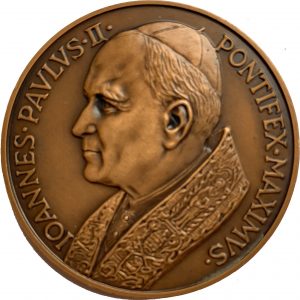

A commemorative medal was also minted on the occasion of the foundation and consecration of the papal bell. It shows a portrait of Pope John Paul II and the circumferential inscription on the front:
IONANNIS PAVLVS – II – PONTIFEX – MAXIMUS
The back shows the Lubentius church in Dietkirchen and the surrounding inscription:
COURTIAL-PILGER STIFTEN PAPSTGLOCKE 1980 FÜR ST. LUBENTIUS DIETKIRCHEN.
(english: COURTIAL-PILGRIMS DONATE PAPAL BELL 1980 FOR ST. LUBENTIUS DIETKIRCHEN)
The commemorative medal was produced by the company GDE Bertoni in Milan. The inscription can be found on the reverse side at the bottom left:
BERTONI-MILANO
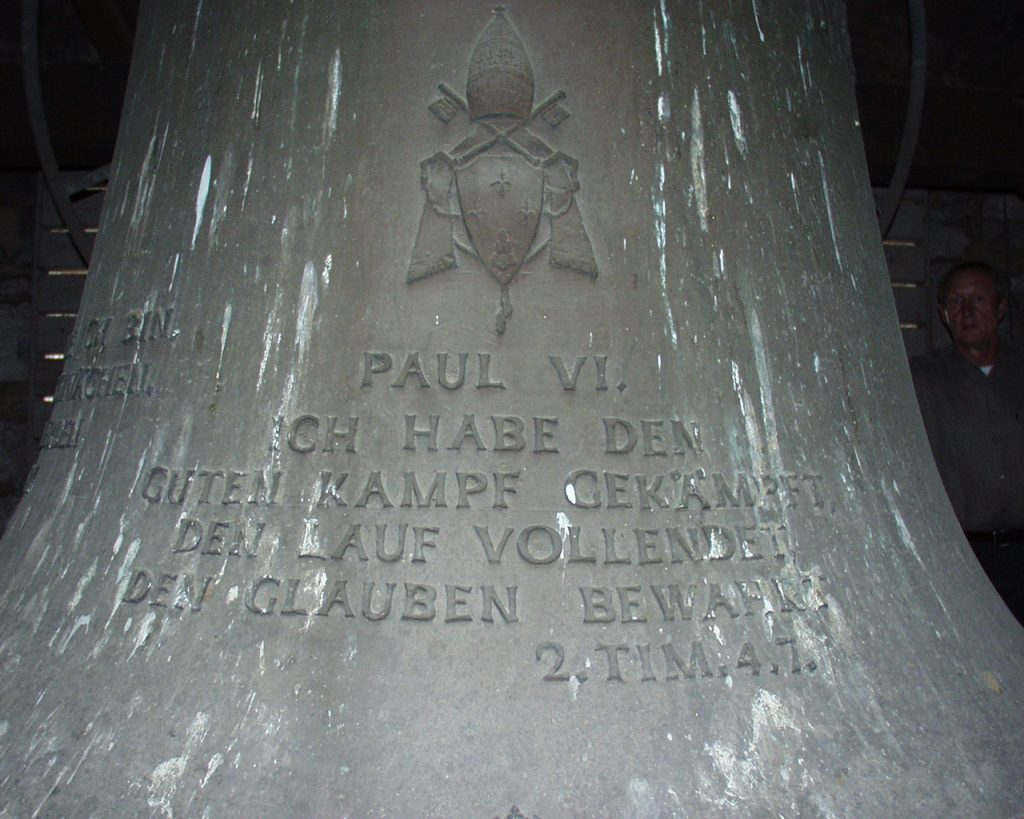
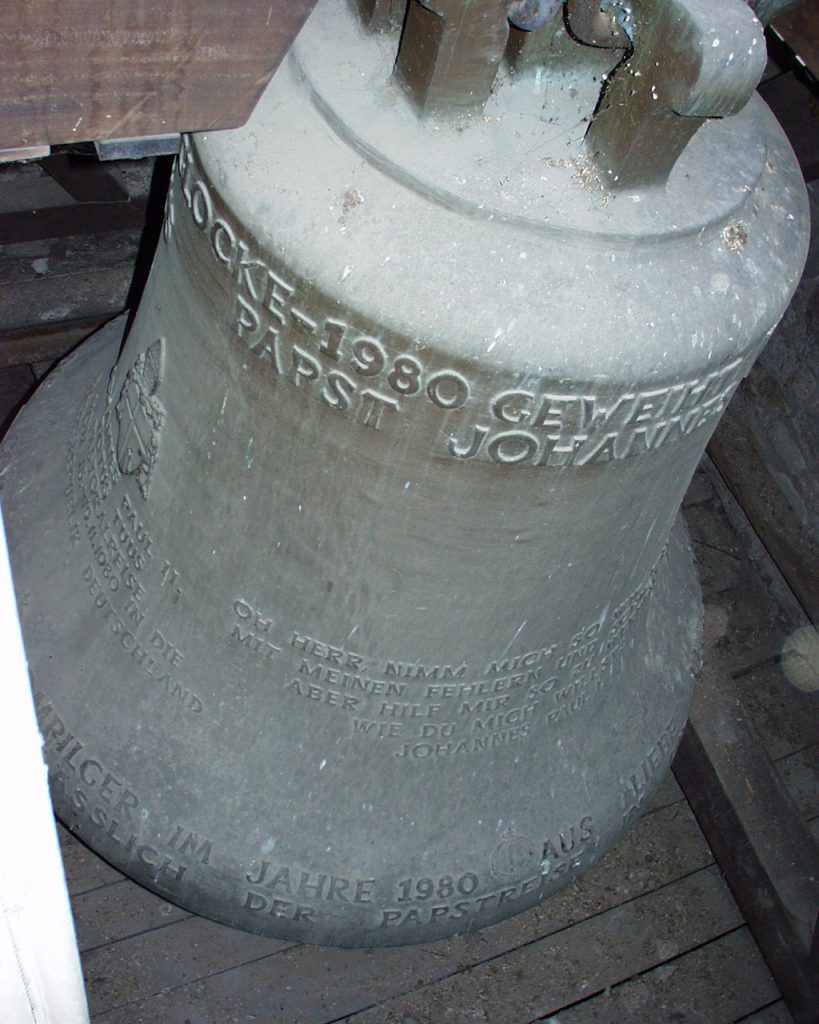
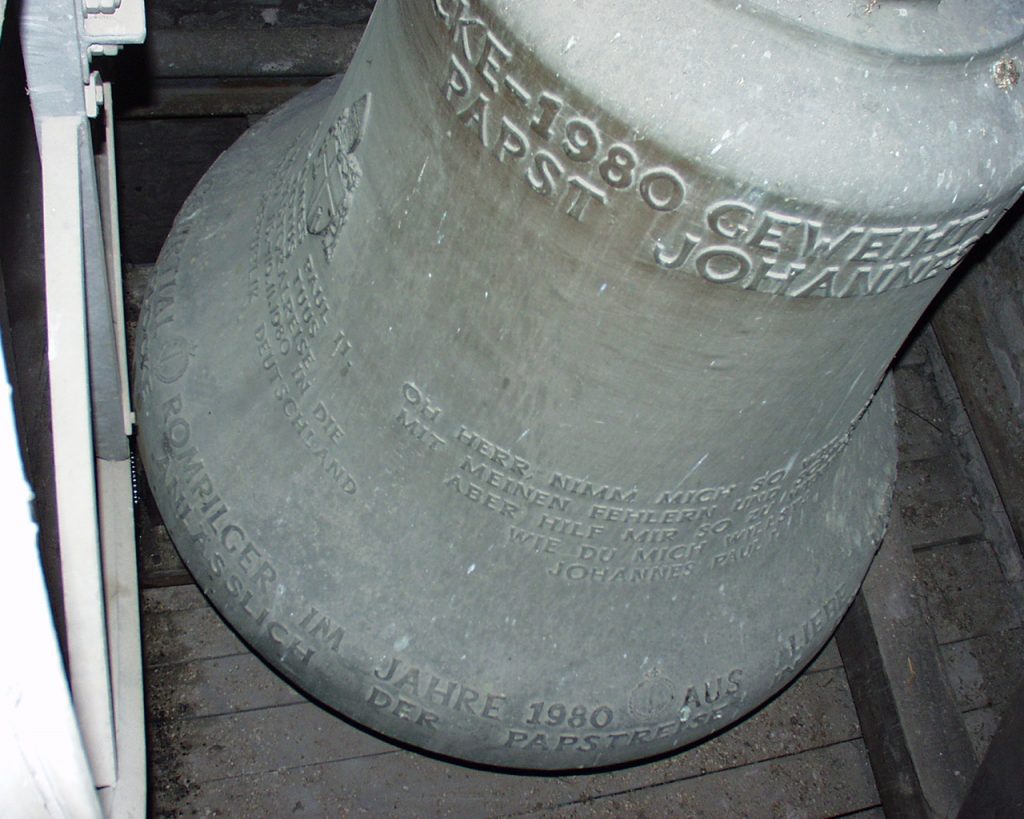
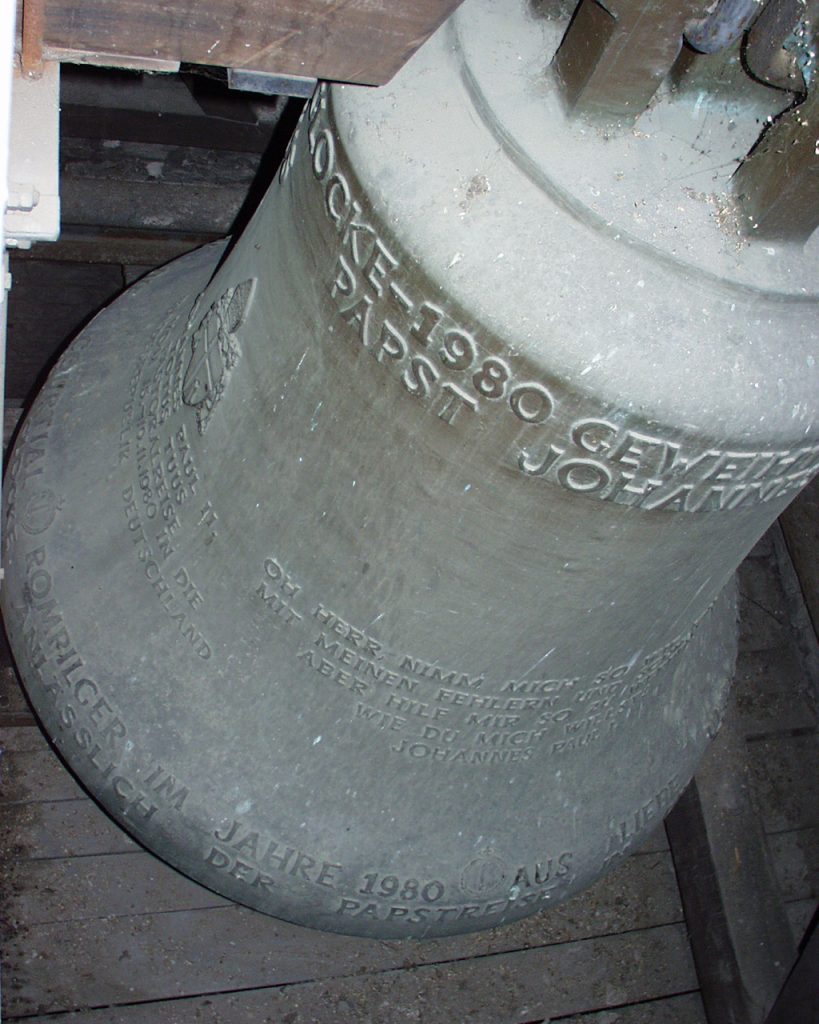

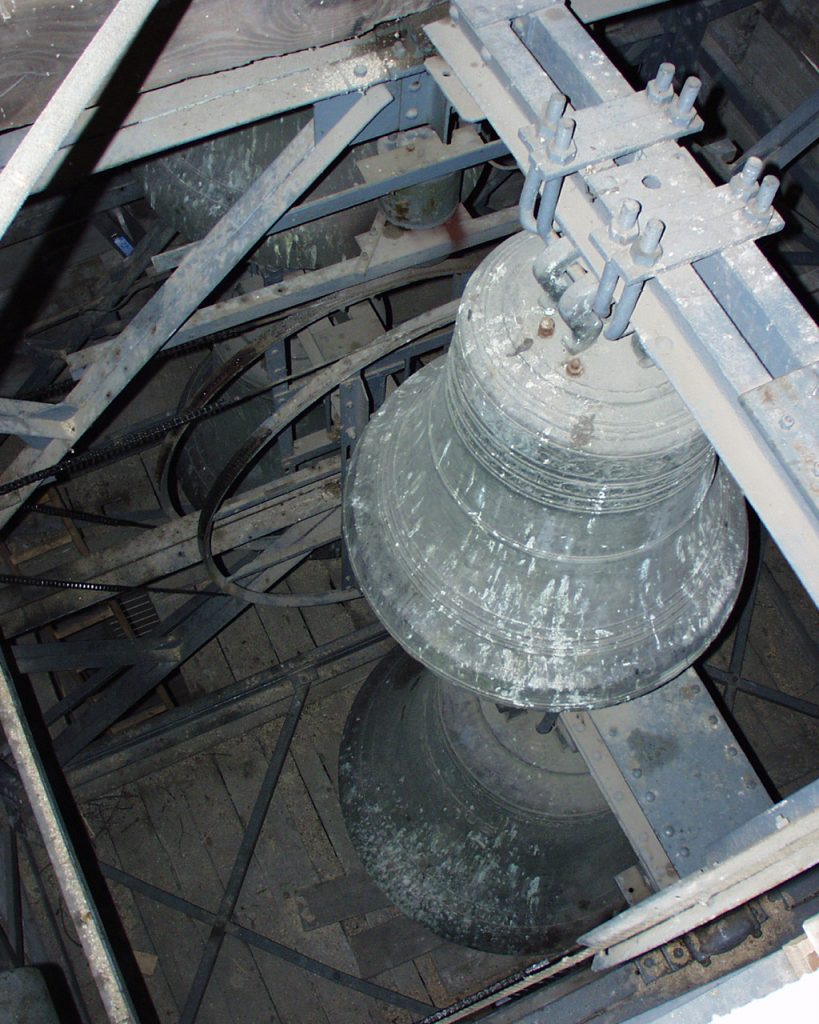

Chimes to mark the time
The tower clock strikes the quarter hours on bell 4, the hours on bell 2, the daily Angelus ringing bell 3 with three times three beats, then bell 4 is rung for a short time.
(Source: Wikipedia – St._Lubentius_(Dietkirchen))
Used as sources:
- School chronicle of the community Dietkirchen
- W.H. Struck in DAS STIFT ST. LUBENTIUS IN DIETKIRCHEN, 1986
- Ferdinand Luthmer, Die Bau- und Kunstdenkmäler des Regierungsbezirkes Wiesbaden, III. Band: LAHNGEBIET
- wikipedia – St._Lubentius_(Dietkirchen)
- https://www.petit-edelbrock-gescher.de/firmengeschichte/
- pictures © Ludwig Ries
